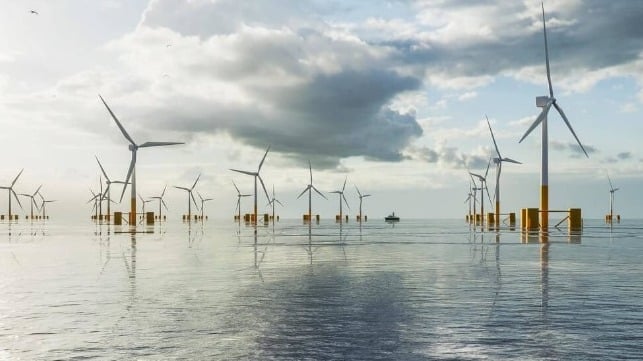Floating Wind Farms Require New Anchor Handling Vessels Says Damen

Damen Shipyards is developing a new class of vessels that will be capable of supporting the next big development in offshore wind, namely the roll-out of large-scale, floating offshore wind turbines. While floating turbines are seen as a key net step, Damen highlights that they will require specialized capabilities to deal with the requirements as wind farms move further offshore such as anchoring chains that could be as much as 40 percent larger than those used today.
The expectations for the floating technology are high with some forecasts indicating that as many as 13,500 floating turbines could be deployed by 2050 generating potentially 200 GW. By nature, they will be positioned beyond the continental shelf in areas that produce the winds required for energy generation but also exposing them to forces ranging not only from the wind to ocean currents and waves. The anchoring systems will have to be able to withstand those forces to prevent the potential for dragging and damaging the farm.
Damen says that the vessels required to handle these turbines and their anchoring systems will need to be much bigger than today’s anchor handling vessels. Given the size of the turbines and the depths of the water in which they will be positioned, Damen says that floating wind turbines will require chains and anchors of unprecedented sizes. They point to research that indicates that each floating wind turbine will require between three and six anchors each, with chain diameters increasing from a typical 152mm for a large offshore structure to upwards of 220mm.
In cooperation with suppliers and vessel operators, Damen is now working on a new class that will be able to meet this need. While Damen reports there is much work to be done, they said that initial feedback from anchor handling specialists has been positive. Damen is also in discussions with other suppliers regarding new deck systems that can accelerate the loading of chain, synthetic rope, steel wire, clump weights, and other possible mooring line components in the harbor while maintaining safety, a major consideration given the sizes and weights being contemplated.
“There are many variables relating to the new vessel concept still to be assessed and explored, not least the final nature of the floating wind turbine mooring systems,” says Damen’s Business Development Manager Offshore Wind, Wijtze van der Leij. “If larger numbers of lighter anchors and chains per turbine are judged superior to fewer but larger, the vessel design will adapt accordingly. But whatever the outcome, rapid growth in the offshore wind turbine sector is just around the corner, and at Damen, we are working hard now on the solutions that will support that growth in ways that are both economical and sustainable.”
The new vessel will be just the latest in a long line of innovative vessels designed and built by Damen for the offshore renewables sector. Recent additions include the Service Operations Vessel (SOV) range with walk-to-work capability for the efficient maintenance of offshore installations, and the new Fast Crew Supplier (FCS) 7011 for fast and comfortable crew transfers.
